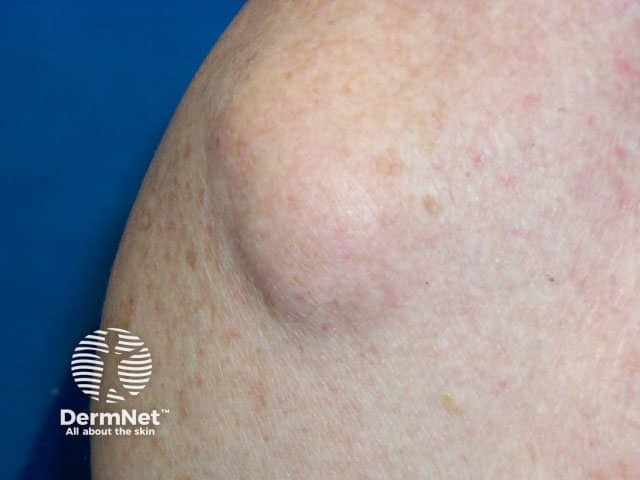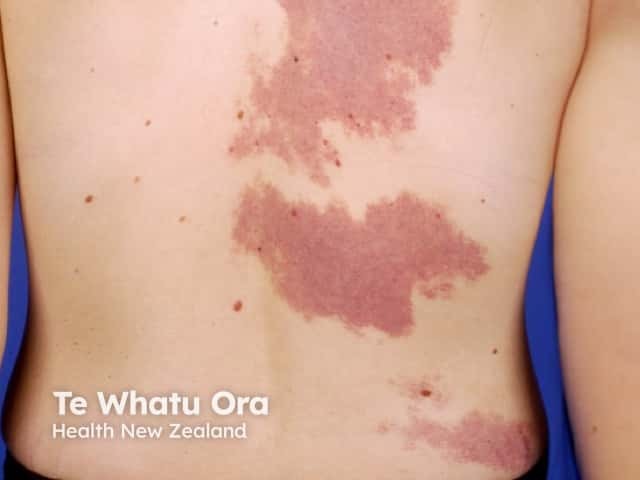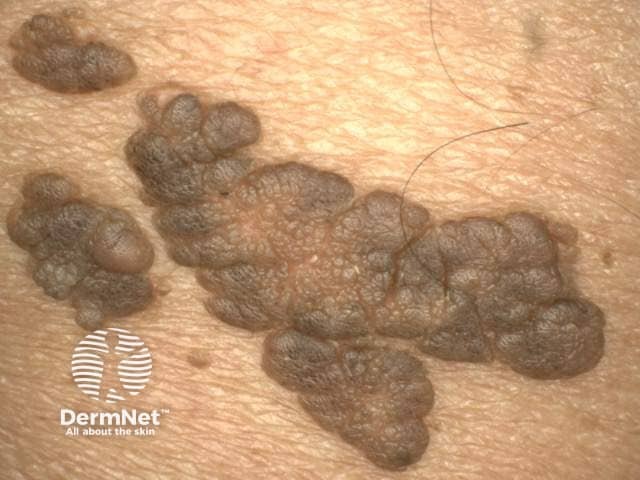Main menu
Common skin conditions

NEWS
Join DermNet PRO
Read more
Quick links
CLOVES syndrome — extra information
CLOVES syndrome
Author: Tae Yeb (Terry) Kim, House Officer, North Shore Hospital, Auckland, New Zealand. DermNet Editor in Chief: Adjunct A/Prof Amanda Oakley, Dermatologist, Hamilton, New Zealand. Copy edited by Gus Mitchell. April 2020.
Introduction Demographics Causes Clinical features Complications Diagnosis Differential diagnoses Treatment Outcome
What is CLOVES syndrome?
CLOVES syndrome is a rare, progressive congenital disorder that involves multiple organs including the skin, the vascular system, and the musculoskeletal system [1].
CLOVES is a mnemonic acronym for:
- Congenital lipomatous overgrowth
- Vascular malformations
- Epidermal naevi
- Spinal/skeletal anomalies/scoliosis.

Lipoma


Verrucous epidermal naevus
Note: images are not from patients with CLOVES syndrome.
Who gets CLOVES syndrome?
CLOVES syndrome is rare and there is no accurate estimation of the incidence or prevalence globally. The mutation is sporadic and there is no known familial predisposition.
What causes CLOVES syndrome?
CLOVES syndrome is caused by a somatic mosaic gain-of-function mutation (a mutation that occurs after the creation of the zygote) in the PIK3CA gene [2]. It is a part of the PIK3CA-Related Overgrowth Spectrum (PROS), a group of rare overgrowth disorders [3].
What are the clinical features of CLOVES syndrome?
CLOVES syndrome presents at birth with vascular malformations, adipose tissue overgrowth (lipomas), epidermal naevi, and varying degrees of bony deformities [4]. Asymmetrical, disproportionate growth may be evident in prenatal scans [5].
The characteristic features of CLOVES syndrome include:
- A large lipoma on the trunk, which may invade nearby structures and organs such as the spinal area [4]
- There is an overlying vascular malformation, which may be low-flow (capillary, venous, lymphatic) or less often, high-flow (arteriovenous)
- Venous malformations present as phlebectasia; arteriovenous malformations tend to be paraspinal [4]
- Lipomatous overgrowth may also affect the legs and feet, with relative lipoatrophy in other parts of the body [1,3,5,6]
- External genitalia may also be involved [7]
- Papillomatous and hyperkeratotic linear epidermal naevi may follow Blaschko lines or vascular/neural structures [8]
- Skeletal changes may be physically debilitating and impair mobility; they may include scoliosis, asymmetrical macrodactyly, widened triangular feet, large hands, and an increased metatarsal gap [4].
What are the complications of CLOVES syndrome?
The complications of CLOVES syndrome depend on its extent. These can include:
- Invasion into the spinal cord may cause spinal compression with neurological compromise
- A severe vascular malformation may lead to anaemia and may cause myelopathy if the syndrome is spinal or paraspinal
- A large tumour-like mass may compress adjacent structures
- Heart failure may occur
- Cognitive impairment and epilepsy have been reported [1,6]
- CLOVES has resulted in postoperative deep vein thrombosis (DVT) and pulmonary embolism (PE) due to persistent embryonic veins [9]
- Nephroblastoma (Wilms tumour), an embryogenic tumour of developing kidneys, has been reported at increased incidence in a large series of patients with CLOVES syndrome [10].
How is CLOVES syndrome diagnosed?
The diagnosis of CLOVES syndrome is based upon:
- The patient's history, which is distinct from other overgrowth syndromes [1]
- The findings on physical examination
- Genetic testing to detect the mosaic mutation in the PIK3CA gene.
Radiological findings can support the diagnosis. Vascular malformations and lipomatous masses can be assessed by magnetic resonance imaging (MRI) [11].
What is the differential diagnosis for CLOVES syndrome?
CLOVES has most commonly been misdiagnosed as proteus syndrome, which is distinguished by the normal appearance at birth, the progression, distortion and body overgrowth with age, and the characteristic connective tissue naevi [12].
Other differential diagnoses for CLOVES syndrome may include:
- Infantile haemangioma
- Arteriovenous malformation
- Epidermal naevus syndromes
- Sturge–Weber syndrome
- Klippel–Trénaunay syndrome
- Parkes–Weber syndrome
- Servelle–Martorell syndrome.
What is the treatment for CLOVES syndrome?
There is no cure for CLOVES syndrome. Improvement has been reported from experimental treatments with:
- Sirolimus (rapamycin) [13]
- Inhibitors of PIK3CA gene mutations, such as alpelisib (approved for the treatment of advanced or metastatic breast cancer) [7].
What is the outcome for CLOVES syndrome?
The prognosis of CLOVES syndrome is usually poor, due to its complications. However, there are indications that treatments with PIK3CA inhibitors will prove effective.
References
- Sapp JC, Turner JT, van de Kamp, et al. Newly delineated syndrome of congenital lipomatous overgrowth, vascular malformations, and epidermal nevi (CLOVE syndrome) in seven patients. Am J Med Genet A 2007; 143A: 2944–58. DOI: 10.1002/ajmg.a.32023. PubMed
- Kurek KC, Luks VL, Ayturk UM, et al. Somatic mosaic activating mutations in PIK3CA cause CLOVES syndrome. Am J Hum Genet 2012; 90: 1108–15. DOI: 10.1016/j.ajhg.2012.05.006. PubMed Central
- Kang HC, Baek ST, Song S, Gleeson JG. Clinical and genetic aspects of the segmental overgrowth spectrum due to somatic mutations in PIK3CA. J Pediatr 2015; 167: 957–62. DOI: 10.1016/j.jpeds.2015.07.049. PubMed
- Alomari AI. Characterization of a distinct syndrome that associates complex truncal overgrowth, vascular, and acral anomalies: a descriptive study of 18 cases of CLOVES syndrome. Clin Dysmorphol 2009; 18: 1–7. DOI: 10.1097/MCD.0b013e328317a716. PubMed
- Schreiber A, Grenier PO, Auger I. A case of congenital lipomatous overgrowth, vascular malformations, epidermal nevi, spinal/skeletal anomalies and/or scoliosis syndrome with lipoatrophy as an important clinical manifestation. Pediatr Dermatol 2017; 34: 735–6. DOI: 10.1111/pde.13256. PubMed
- Kasinathan A, Sankhyan N, Ahuja CK, Singhi P. CLOVE Syndrome. Indian J Pediatr 2018; 85: 79–80. DOI: 10.1007/s12098-017-2416-z. PubMed
- López Gutiérrez JC, Lizarraga R, Delgado C, et al. Alpelisib treatment for genital vascular malformation in a patient with congenital lipomatous overgrowth, vascular malformations, epidermal nevi, and spinal/skeletal anomalies and/or scoliosis (CLOVES) syndrome. J Pediatr Adolesc Gynecol 2019; 32: 648–50. DOI: 10.1016/j.jpag.2019.07.003. PubMed
- Martinez-Lopez A, Blasco-Morente G, Perez-Lopez I, et al. CLOVES syndrome: review of a PIK3CA-related overgrowth spectrum (PROS). Clin Genet 2017; 91: 14–21. DOI: 10.1111/cge.12832. PubMed
- Reis J 3rd, Alomari AI, Trenor CC 3rd, et al. Pulmonary thromboembolic events in patients with congenital lipomatous overgrowth, vascular malformations, epidermal nevi, and spinal/skeletal abnormalities and Klippel-Trénaunay syndrome. J Vasc Surg Venous Lymphat Disord 2018; 6: 511–16. DOI: 10.1016/j.jvsv.2018.01.015. PubMed
- Peterman CM, Fevurly RD, Alomari AI, et al. Sonographic screening for Wilms tumor in children with CLOVES syndrome. Pediatr Blood Cancer 2017; 64: 10.1002/pbc.26684. DOI: 10.1002/pbc.26684. PubMed
- Bertino F, Braithwaite KA, Hawkins CM, et al. Congenital limb overgrowth syndromes associated with vascular anomalies. Radiographics 2019; 39: 491–515. DOI: 10.1148/rg.2019180136. PubMed
- Cohen MM Jr. Proteus syndrome review: molecular, clinical, and pathologic features. Clin Genet 2014; 85: 111–19. DOI: 10.1111/cge.12266. PubMed
- Hammill AM, Wentzel M, Gupta A, et al. Sirolimus for the treatment of complicated vascular anomalies in children. Pediatr Blood Cancer 2011; 57: 1018–24. DOI: 10.1002/pbc.23124. PubMed
On DermNet
- Epidermal naevus
- Capillary vascular malformation
- Sturge–Weber syndrome
- Klippel–Trénaunay syndrome
- Proteus syndrome
